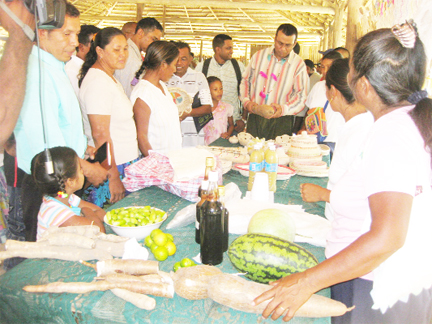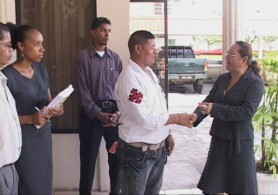GUYANA - Direct impacts on individuals in indigenous villages surrounding the proposed Romanex gold-mining project at Marudi, Region Nine would be limited but there are potential indirect impacts that create social risks.
This is according to the Environmental and Social Impact Assessment (ESIA) draft report on the project.
The report- on the key socio-economic findings and issues/concerns related to the project noted that there are few communities located in close proximity to the proposed mine and direct impacts on individuals in indigenous villages would be limited. However there would be potential indirect impacts that create social risks due to the project such as possible influx in the remote areas due to upgrading of the access road from Aishalton to Marudi, it says.
The ESIA has been submitted to the Environmental Protection Agency (EPA) and the agency is now inviting the public to comment on it before a decision is made on whether to grant or deny an environmental permit. In an advertisement in the Guyana Chronicle yesterday, the EPA said that the public has 60 days from the time of publication of the notice to make written submissions on the project to the Agency.
Romanex Guyana Exploration Limited is seeking to undertake alluvial gold mining at Marudi Mountain. The large-scale project will entail the excavation of mineralized gravel, the establishment of a mineral processing plant for the recovery of gold and the construction of supporting facilities, buildings and road. No chemicals will be used and the project will serve as a demonstration of non-chemical recovery of gold from placer deposits, according to the Project Summary. The proposed mine is 155 kilometres (Km) from Lethem and 28 km from Aishalton. Karaudarnau, the closest community to the mine, is linked to the area by a trail and is 20.5km away.
Hunting
The draft ESIA says that a socio-economic baseline study was undertaken to create a profile of the communities in and around the project area. It noted that there are few communities located in close proximity to the project. The report says that the development of the mine and potential employment opportunities may attract people to the site for work. It stated that the operation of the mine may restrict access to the area for hunting and fishing and this may result in loss of revenue/livelihood for the members of the communities who use these areas. “These impacts will be mitigated by working with indigenous communities to minimize the impacts. The operations will create employment opportunities for residents of the area. The project will create a demand for skilled labor. The project may therefore result in people in the communities acquiring new skills”, it goes on to say.
It was noted that the commencement of construction activities at the site may attract local people who sell goods and services to the workers, including prostitutes. “Social interaction with other groups is also likely to bring about an increase in alcohol and drug abuse, prostitution and crime”, it says. The report noted that the influx of people could potentially increase pressures on existing resources in the area. It noted that the site is in a remote area which lacks resources and infrastructure and increases in population will pressurize the limited resources such as land, water, forest use and the current goods and services in the area. In addition, uncontrolled access to the area may create security issues and result in increased crime and indirect impacts on communities in proximity to the mine site, it says.
Uncontrolled influx
It further noted that the uncontrolled influx of people from outside could possibly create health risks to the Romanex employees and vice versa. This may be manifested in the form of increased transmission of contagious and other diseases. Influx of sex workers often leads to a rise in HIV and other STDs. The circulation of money from wages and salaries would sustain all of the workers’ leisure activities. This may increase the demand for alcohol, drugs and sexual services especially for those migrant and expatriate workers. In the mid-term this may bring about an increase in sexually transmitted diseases, the report states adding that “these are moderate impacts (high severity, low likelihood)”. However, it noted that the impacts will be mitigated by working with the village councils in the area to control access to the mine site as well as the Guyana Geology and Mines Commission. Additionally according to the report, Romanex will incorporate into their employment contract a stipulation that dismissal will result for employees who patronize service providers. The mitigation measures will result in minor impacts (low severity, low likelihood), the report says.
Meantime, the potential impacts related to construction activities at the mine site and to mining operations include potential impacts to the atmosphere, aquatic and terrestrial resources and to human, socio-economic and cultural resources, the document states. It says that potential impacts to soil could result from widening of the access road from Aishalton to Marudi and from vegetation clearance of the creek flats to be mined and excavation for creek diversions.
“The likelihood of soil erosion and sedimentation will be minimized or avoided by the implementation of the Best Management Practices (BMP). The movement of heavy equipment during construction and mining may impact soil resources by causing rutting and compaction of susceptible soils. The impacts to the soil resources are expected to be minor (low severity, low likelihood). Topsoil mixing could potentially occur during the project execution. BMP implemented during construction and operation will result in minor impacts”, the Executive Summary of the ESIA states.
It stated that construction works will result in emissions of fugitive dust and products of combustion. Impacts to air quality could be moderate. These impacts will be mitigated by scheduling land clearing activities to less windy days, limiting vehicle speed during construction to a maximum 30 km/hr and employing dust suppression technique. Analyses indicated very minor changes in air quality resulting from equipment emissions, the ESIA report says.
Carbon dioxide
According to the document, clearing of tropical forest will result in approximately 1750 and 2600 tonnes of carbon dioxide (CO2) per year no longer being sequestered by the forest. The project will also generate approximately 5200 tonnes of CO2 each year. It says that approximately 217 hectares of tropical forest will be cleared for the mines, widened roadway and related facilities. “This will result in a loss of approximately US$8391 per year based on the 15 million hectares being able to annually generate US$580 million”, the document states. It noted that the entire value of this would not be restored by reclamation of the mined out areas since the zone includes areas cleared for the Aishalton to Marudi access road upgrade. “The impacts of the project on the LCDS (Low Carbon Development Strategy) are consequently minor (low likelihood, low severity). No mitigation is necessary”, the document states. It had noted that the project will entail progressive reclamation of areas cleared for mining thus the project impacts on forest resources will consequently be carbon neutral.
Soils
Meantime, the ESIA report states that removal of the surficial soils will result in insignificant impacts on the geology of the area. An erosion and sediment control plan will mitigate potential impacts to water quality from erosion. It states that the potential for accidentals spills of fuels, oils and grease and the associated contamination of surface waters will be minimized by implementation of a Spill Prevention and Contingency Plan.
On the roadway from Lethem to Aishalton, it stated that the project will not result in significant increases in the level of traffic on the Lethem to Aishalton road and the upgraded road from Lethem to Aishalton would impact positively on the social sectors particularly in health and education.
According to the ESIA report, the project will introduce chemical free technology to Guyana’s gold mining industry and will serve as a demonstration project for application elsewhere.
It stated that an Environmental Management Plan was developed to mitigate the potential negative impacts and risks and to enhance the potential positive impacts of the proposed action. Environmental management measures address the environmental impacts and risks to both the physical and socio-cultural environments. A monitoring programme has been developed for the plant and this will provide data which would serve as the basis to determine the environmental performance of the operation. “The facility will be monitored to confirm its adherence to sound environmental management practices and contractually established operational standards. Monitoring will be conducted during the construction and operation phases of the project”, the report states.
Source: Stabroek News
















